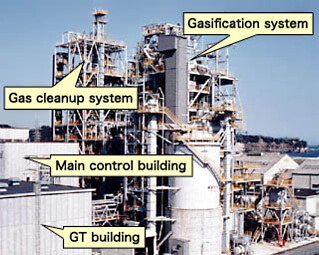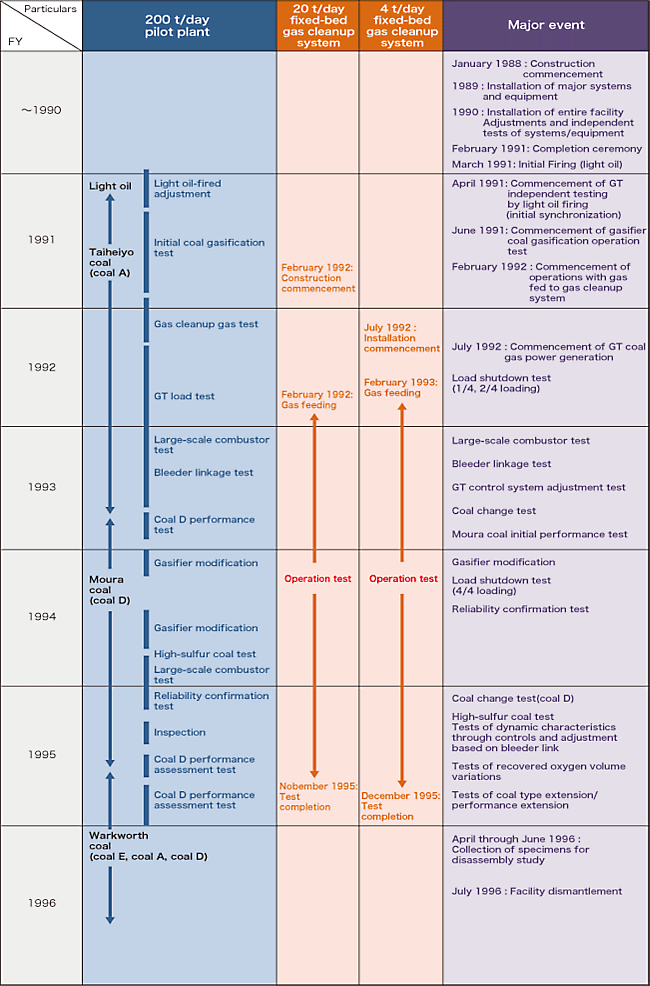History of R&D
History of IGCC Research and Development Work

Pilot plant test
1.Overview of the Nakoso Pilot Plant Test
The Engineering Research Association for Integrated Coal Gasification Combined Cycle Power Systems (IGC Association) was founded in fiscal 1986 by a partnership among nine power companies, the Electric Power Development Co., and the Central Research Institute of Electric Power Industry, leading to the launch of the government-subsidized Nakoso Pilot Plant Project. Although gasification test began in June 1991, sustained gasifier operations were not achieved in the first attempts due to frequent slagging (i.e., adhesion and accumulation of melted coal ash) clogging the gasifier. In response, thorough modifications of the gasifier were implemented in fiscal 1994. Steady progress thereafter eventually allowed sustained operations for a period of 789 hours. Test ended in success in February fiscal 1996.
Nakoso Pilot Plant

Principal Specifications
- Scale:
- coal 200 t/day (equivalent to 25,000 kW in electric power output)
- Type:
- Gasifier–entrained bed air-blown gasification
- Organizational relationship:
- Government → NEDO → IGC Association
- Location:
- Site of the Nakoso Power Station of Joban Joint Power Company
Record of Pilot Plant Operations
(cumulative hours)

2.Record of Pilot Plant Operations

3.Results of Pilot Plant Operations Test
| System Verification | Confirmed the validity of basic technologies for an integrated air-blown gasification system consisting of a gasifier, gas cleanup system, and gas turbine. Identified various critical conditions (e.g., fuel calorific value) for an IGCC system. Identified phenomena (e.g., slagging) unique to coal gasifiers otherwise not possible with essential technologies test. |
|---|---|
| Scale up Data Acquisition |
I dentified appropriate scale up methods for the gasifier and gas cleanup system. (Implementation of scale up calls for preliminary verification of as many factors as possible.) |
| Thermal Efficiency |
Achieved initial target values for all systems. Identified need for further reductions in auxiliary power requirements to offset high power requirements relative to power generation based on pulverized coal. Tests and conceptual designs confirmed a potential efficiency (net) of over 43% over 1300°C-class advanced type gas turbines. |
| Economy | Identified a need for further reduction of construction costs because the overall cost (Price/MWh) estimated to be slightly higher than that of using a conventional pulverized coal power plant;the final goal of the development of IGCC is to meet the cost(Price/MWh)equivalent to that of a conventional pulverized coal power plant. |
| Environmental Compatibility |
Identified prospects for achieving values of 20 ppm, 20 ppm, 1 mg/m3N, or less at the stack outlet, respectively, for SOx, NOx, and dust, based on the results of operations test. |
| Coal Type Flexibility |
Confirmed the feasibility of operations with coal of Warkworth/Moura quality with the addition of a melting-point lowering agent (limestone) and oxygen enrichment, based on the results of operation test with three types of coal. |
| Operating Characteristics |
Identified the prospects of achieving a cold startup time of one day (approx.) and load-following capabilities on par with that of power generation using pulverized coal, based on results of operation test and conceptual design studies. |
| Reliability | Achieved a cumulative operating time of 4700 hours while encountering and resolving issues associated with the demonstration plant to verify the reliability of continuous operation. Acquired a body of knowledge on the durability of materials (i.e., several years or so) and other aspects of individual systems and equipment. |
FS
Feasibility Study
In fiscal 1997, comprehensive evaluations of individual types of IGCC (i.e., dry feed/slurry feed, oxygen-/air-blown gasification, dry/wet gas cleanup) were performed for factors such as reliability, thermal efficiency, environmental characteristics, economy, and other aspects, with a view to selecting the most promising demonstration plant configuration for development in Japan.
Based on the conclusions, a combination of a dry feed oxygen enrichment air-blown gasifier (tested at the Nakoso pilot plant) and a wet gas cleanup system was determined to be the best choice for a demonstration plant.
Based on the IGCC configuration selected based on these results, studies of systems and equipment specifications and of effects associated with changes in design parameters, trial designs of commercial plants, and other tasks were performed in fiscal 1998.
Major Items Studied
1)Factors related to the use of low-grade coals
2)Comparisons of various methods for supplying coal in powder form
3)Effects of CO2 selectivity of H2S absorbing solution on the IGCC system
4)Effects of the oxygen purity of air separation units on the IGCC system
5)Trial design of an IGCC commercial plant using a 1500℃ class gas turbine
Essential Technologies Research
Essential Technologies Research
During fiscal 1997 and fiscal 1998, research was performed on essential technologies for individual systems and equipment using a test facility in four areas: coal supply stabilization; scale up of the gasifier; improvements in the reliability of the gas cleanup system; and improvements in the reliability of the gas turbine system. The goal was to resolve issues remaining with the pilot plant.
1) Coal Supply Stabilization
The high-concentration transport of pulverized coal using nitrogen was tested to acquire a body of knowledge on ways to ensure a stable supply of coal and to find potential applications to demonstration plants.
2) Scale Up of the Gasifier
Forecasts for the possible scale up of the gasifier were made and pertinent evaluation tests performed using a 24 t/day gasifier test system. The test results obtained were more or less identical to the results of performance forecast simulations, suggesting a highly reliable demonstration plant was possible.
3) Improvements in the Reliability of the Gas Cleanup System
Coal gas contains carbonyl sulfide (COS). Test was performed to examine the performance and durability of the catalyst used to convert COS into hydrogen sulfide (H2). In addition, tests were performed to examine the performance of lime/gypsum methods in removing sulfur for high concentrations of SO2 and performance in removing trace impurities present in coal gas, among other aspects.
Tests of catalysts showed that certain materials might be suitable for the demonstration plant. While the results of desulfurization performance test indicated remarkably high desulfurization rates, test on the removal of impurities pointed to the likelihood of removing ammonium and other types of impurities.
4) Improvements in the Reliability of the Gas Turbine System
Evaluation-oriented studies were performed on the adhesive characteristics of deposits collecting on the blades of the gas turbine and the performance of anticorrosion coatings, clarifying the mechanism of deposit adhesion and allowing the establishment of effective coating methods for the blades in the gas turbine used in the demonstration plant.
Preliminary Verification Test
Preliminary Verification Test
To improve plant reliability, reliability verification test was performed from fiscal 1999 to fiscal 2001 on the gasifier, gas cleanup system, and gas turbine, in line with the design research underway, before full-scale design work for a demonstration plant.
1) Reliability Verification Test of the Gasifier Component Equipment
Gasification tests were performed using a 24 t/day coal gasifier test facility to investigate the potential for wear and other detrimental phenomena on various parts. No anomalies such as wear, burns, or malfunctions were noted, confirming the reliability of the materials and parts (specifications) being considered.
The test also involved varying oxygen concentrations and types of coal and using the types of coal regarded as candidates for use in the demonstration plant, leading to a good understanding of the gasification characteristics of individual coal types.
Additionally, high-temperature gas filter evaluation test identified the characteristics of differential pressure/dust collection based on filter types, providing data to support model selection.
Equipment (large-scale powder valve, high-pressure soot removal units) of a scale equivalent to that of the demonstration plant were also used to undertake operations test under conditions that simulated operating conditions at an actual plant, thereby verifying the reliability of the equipment in question.
2) Reliability Verification Test of the Gas Cleanup System Component Equipment
In connection with a wet gas cleanup process, the deposition and sublimation behavior of NH4Cl (ammonium chloride) resulting from the HCl and NH3 of coal gas was studied. The results clarified the associated characteristics of NH4Cl.
To understand the deterioration behavior of the solution (MDEA solution) used to absorb the H2S present in coal gas, absorption deterioration test was performed with simulated gas and basic test equipment. These results were used to assess the deterioration characteristics of the absorption solution.
In addition to the foregoing, the reliability of the equipment was verified by undertaking durability test of the diversion valve (of a scale equivalent to the demonstration plant) of the H2S incinerator, confirmation test of the performance for the removal of impurities present in coal gas using a wet gas cleanup all-inclusive system equipped with an actual coal gas generator, and test to determine ways to prevent the adhesion of ammonium chloride in the coal gas heat exchanger (GGH).
3) Reliability Verification Test of the Gas Turbine Component Equipment
With respect to the adhesive characteristics of the deposits, the results showed that the composition of the actual extraneous matter and that of matter identified using the condensation composition formula were nearly identical, confirming the validity of the formula.
With respect to the penetration of corrosive elements into coating materials, work was done to clarify the correlation with concentrations of corrosive elements and the temperature of the metal making up the blades.
Moreover, to acquire dependence data on the relationship of deposits pertaining to metal temperature/time and on that pertaining to pressure/temperature, test specimens and actual blades were exposure-tested while varying numerous parameters.
Design Research
Design Research
Work from fiscal 1999 to fiscal 2001 focused on research development leading up to the construction of a demonstration plant consisted primarily of tasks such as conceptual design and assessment studies of the safety and reliability of the IGCC system.
1) Conceptual Design
Work on plant conceptual design began to determine test conditions for preliminary verification test and to identify a plant model for the study assessing the safety and reliability of the IGCC system (discussed later).
In fiscal 1999, the rough boundary parameters for various demonstration plant components were determined through rudimentary equipment designs of the overall plant. In addition, issues and constraints expected to emerge in the demonstration plant were identified for individual systems and equipment, leading to possible solutions for such issues and constraints.
Work in fiscal 2000 analyzed the extent to which variations in parameters such as atmospheric temperature, gasification air ratio, and oxygen concentration affected the overall IGCC system to determine safety margins and other factors and to identify optimal system and equipment capacity.
Rudimentary equipment designs for the demonstration plant incorporated the results of this study.
2) Assessment Study of the Safety and Reliability of the IGCC System
In fiscal 1999, using a failure mode and effect analysis (FMEA) approach–i.e., a method for assessing safety and reliability–we identified aberrant occurrences for individual systems and equipment. We performed follow-ups to analyze their frequency and potential effects on the IGCC system and to identify potential solutions. The results of the work led to a good understanding of the safety and reliability of the individual systems and equipment.
In fiscal 2000, another method for assessing safety and reliability, a hazard and operability analysis (HAZOP) that took an approach differing from FMEA, was used to project and assess potential causes of aberrant occurrences and the scope of their effects.
In addition, changes in the operating condition (dynamic characteristics) of the systems and equipment in response to normal changes in loads and at the startup/shutdown of the demonstration plant were forecast through simulations by studying methods for running and controlling the demonstration plant.
